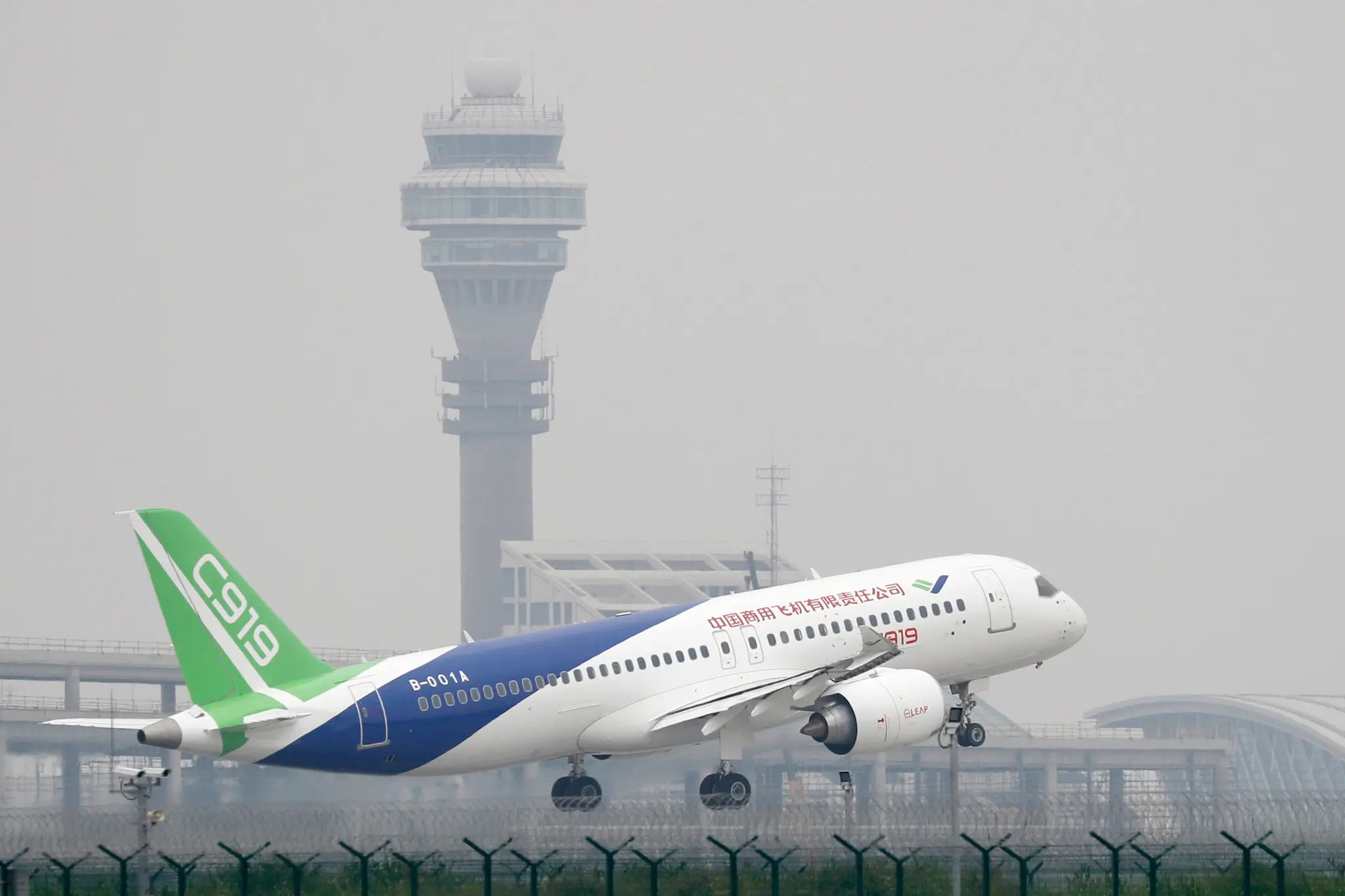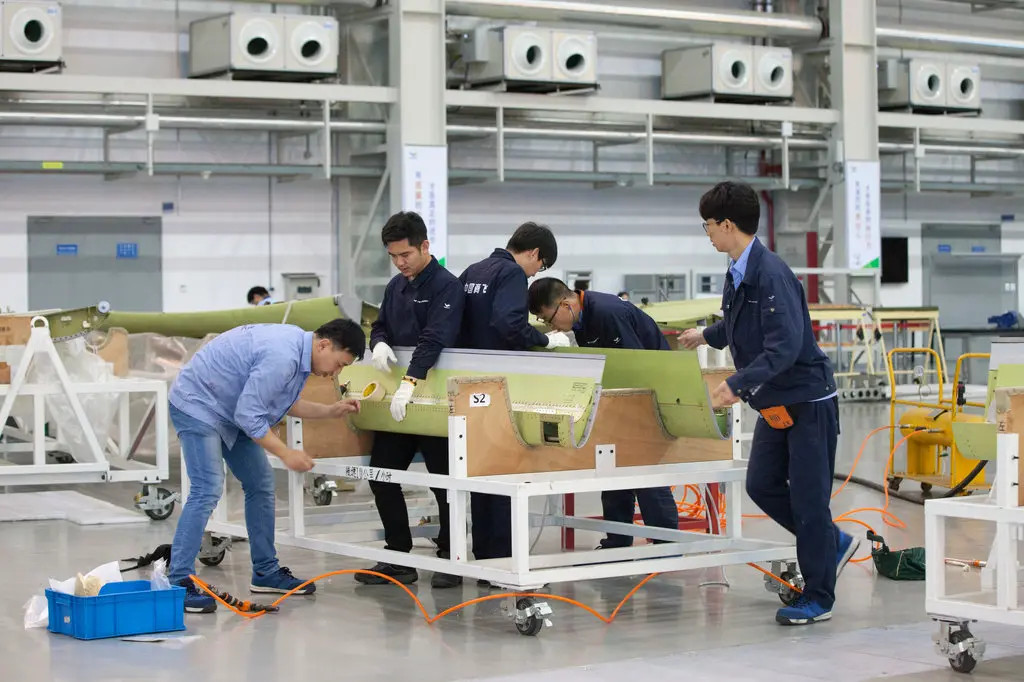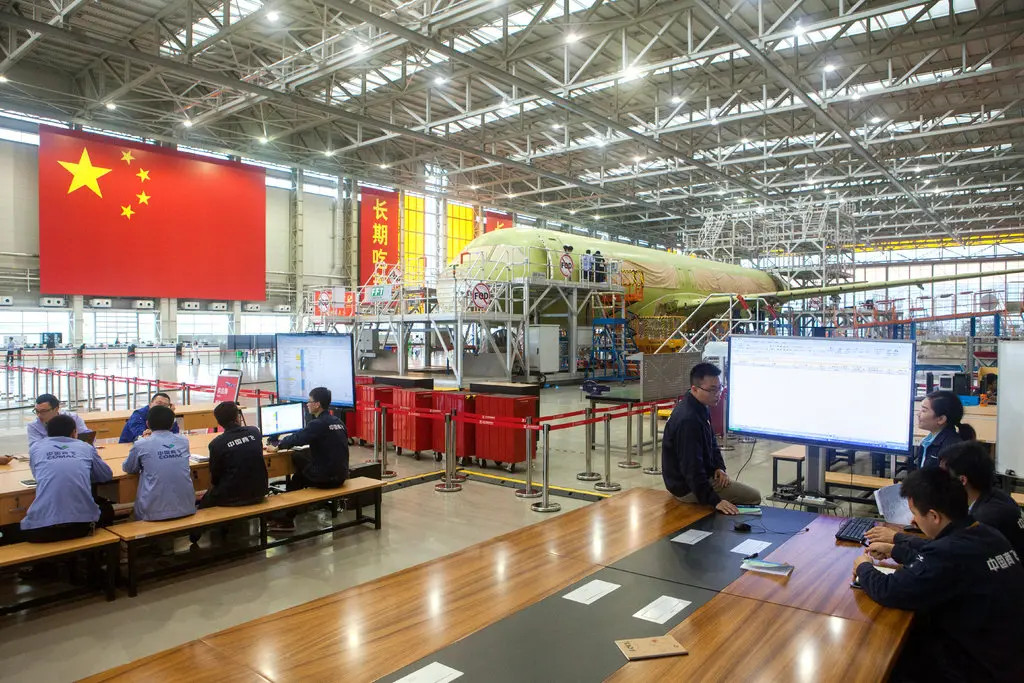
Date: 2025-10-05 Page is: DBtxt003.php txt00028580
CHINA
CHINA'S NEW JETLINER
China’s New Jetliner, the Comac C919, Takes Flight for First Time
CHINA'S NEW JETLINER
China’s New Jetliner, the Comac C919, Takes Flight for First Time

A C919 passenger jet taking off at Pudong International Airport in Shanghai on Friday.
The plane symbolized the industrial might of an emerging superpower — and its dream
to dominate a new technological era. ... Credit...Pool photo by Andy Wong
Original article: https://www.nytimes.com/2017/05/05/business/china-airplane-boeing-airbus.html
Peter Burgess COMMENTARY
I am impressed by the economic and technical progress that has been made in China over the past five decades
Mostly, Americans do not remember the 1970s when President Nixon started a diplomatic dialog with the People's Democratic Republic of China that included China and the USA playing a 'ping-pong' match. It was referred to as 'ping pong diplomacy'.
Later in the decade, President Carter hosted the President of China, Deng Xiaoping in Washington and over time there has been an impressive growth in the relationship between China and the United States as well as with the West in general.
The technical and economic progress of China since the 1970s has been impressive ... more rapid than progress achieved anywhere in all of history at this scale.
By comparison, the 'progress' in the United States since the 1970s has been negligable. While the United States has been responsible for a lot of impressive technologial progress, the majority of the US population has become 'poorer' over the past four decades since the Presidency of Ronald Reagan.
Trump in his second term as President of the United States has been setting the stage for a massively accelerated decline in the quality of life for most Americans. The President and his family are in the process of enriching themselves in a multitude of ways many of which one would have thought were illegal and impossible.
Sadly ... the sensible world outside the United States seems unable to do much to end the damage being caused by President Trump and his enablers.
25 years ago, it was expected that this would be America's century. The reality is more likely that China and India and everyone else except the USA will be sharing success while the USA wonders what happened!
To me it is obvious that Donald Trump and his enablers are a big problem for the USA and much of the world. However, they are a symptom of a much bigger problem. Corporate greed and financial profits have become the main drivers of corporate decision making in the 45 years since Reagan became President and the GOP adopted Reaganomics. The GOP sold America on the idea of 'Trickle Down' economics and in the process enabled the biggest concentration of wealth at the 'top of the pyramid' in all of history ... a situation that continues in the present!
I do not know how fast the world will 'gang up' aginst a Trump led United States and how powerful such a alliance will become. There is a lot of telk. Whether much of this talk will become reality is an open question.
I am fairly certain that Trump is going to accelerate a massive decoupling of major economic flows where the USA has substantial control. Canada has started this process and it is fairly certain that many of the US / Canadian economic ties have already been broken and will unlikely to get repaired as long as Trump has any power!
Canada has been 'nice' to the United States for a long time. Fifty years ago, Canada needed the USA, but much less so in the last 20 years ... andreally not at all now!
The USA 'needs' Canada not more than Canada 'needs' the USA. Canadian oil and electricity needed by the USA can be diverted to other markets much more readily now than in the past and this is already happening. The USA will have to 'play nice' before next winter and the US mid-West starts to freeze!
The world is reorganising away from the USA faster now than at any time in my lifetime ... at any time since the end of WWII. My ipression is that the majority of the American population has no idea what is in progress, and will not 'wake up' or 'see reality' until it is way too late. This is not a good time for the United States and Trump is most likely to make it substantially worse!
Peter Burgess
Written by Keith Bradsher
May 5, 2017
SHANGHAI — China’s commercial aerospace dreams took wing on Friday, as the first Chinese-built passenger jetliner completed its first public flight test, embodying the country’s ambitions to take on the industry champions, Boeing and Airbus.
With a brisk breeze blowing through light smog under overcast skies, a large crowd of government officials and aerospace executives gathered to watch as the C919, white with a green-and-blue striped tail, underwent a lengthy preflight check, then rumbled down a runway and into the sky for a test flight that lasted about an hour.
The aircraft landed safely, and Comac, its manufacturer, declared it a success. But the program still has a long journey ahead. It is emblematic of China’s challenge as it seeks to become a leader in aerospace and other critical technologies like electric cars, advanced microchips and artificial intelligence.
The C919 is years — if not decades — behind aircraft made by Airbus and Boeing that are cheaper to fly and easier to maintain. Safety regulators in Europe, the United States and elsewhere still have to certify the plane before it can be sold outside China. And including parts like the engines, its cockpit and its belly, the C919 is filled with gear made by Western industrial giants like General Electric and Honeywell.
But on Friday, none of that mattered. For a country that only 40 years ago was one of the poorest in the world, the C919 symbolized the industrial might of an emerging superpower — and its dream to dominate a new technological era.
Planning for the 158-seat C919 began more than a decade ago, but the plane has become a centerpiece of the country’s more recent ambitions to become largely self-sufficient in many high-tech goods and to export them as well. That plan, called Made in China 2025, worries many Western businesses who fear competing against government-supported Chinese companies.

Employees on Thursday in the hangar of the building where a second C919 aircraft is being built. The manufacturer said that it would decide whether the aircraft was ready for large-scale production after building six test planes.Credit...Giulia Marchi for The New York Times
“We used to believe that it was better to buy than to build, better to rent than to buy,” President Xi Jinping of China told workers during a recent visit here. “We need to spend more on researching and manufacturing our own airliners.”
China’s investment in civilian aircraft manufacturing is enormous. The Commercial Aircraft Corporation of China, better known as Comac, unveiled the extent of its activities for the first time on Thursday, showing off a complex of more than 110 buildings.
In one of the seven towering gray manufacturing buildings sat the second C919, still being assembled. Workers in dark blue uniforms installed components in the plane’s wings and cargo area, the rattling of their tools echoing through a cavernous space that could accommodate many more aircraft on a production line.
The second C919, coated in green anticorrosion paint and not yet displaying any airline’s colors, will not be ready until September, said Bao Pengli, Comac’s deputy director of project management for manufacturing and final assembly. Only after building six test planes will Comac decide whether it is ready for large-scale production, he said.
Comac says it already has 570 orders from 23 buyers. But those have almost entirely come from Chinese companies and a couple of small overseas air carriers with links to China. A notable exception is an order for 20 planes from General Electric Capital Aviation Services; G.E. is also a big supplier to the C919 program.
The C919 is designed to compete with the Airbus 320 and the Boeing 737, single-aisle planes that are the workhorses of the world’s airlines. For Comac, the plane represents the culmination of decades of work; for Airbus and Boeing, it is a challenge to a profitable duopoly that has endured for decades.
But it is unclear that China can produce aircraft that are as efficient and reliable as even the current generation of Boeings and Airbuses.

The hangar of building where a second C919 aircraft is being built. Comac says it already has 570 orders from 23 buyers.Credit...Giulia Marchi for The New York Times
“If you have a slight rivet head protrusion, it does affect the air flow,” and that may mean extra fuel consumption, said Martin Craigs, chairman of the Aerospace Forum Asia, a commercial aircraft industry trade association.
China has learned a lot in recent years about how to build single-aisle planes by making many parts for Boeing 737s and by assembling entire A320s for Airbus. But the country’s dream of becoming a competitor in the global market for commercial aircraft started in 1972, when President Nixon visited China in a Boeing 707.
Chinese officials loved the plane and later bought 10 Boeing 707s, as well as 40 spare Pratt & Whitney engines. China to some extent copied the fuselages of the 707 for a small production run of experimental Y-10 planes using the additional engines.
Decades later, those experiences and a fast-developing aviation sector — China has the world’s second-busiest behind the United States — mean there are few questions about the C919’s safety.
Arnold Barnett, the dean of aviation safety statistics at the Massachusetts Institute of Technology, said that China had had only one fatal crash in the past decade, even as its aviation sector expanded. One person has been killed per 70 million passengers boarded in China, compared with one passenger per 25 million boardings in the West, he said.
Gary Moran, the head of Asia aviation insurance at Aon, a large global insurance broker, said that as insurers assessed the risks of a new aircraft like the C919, they were likely to be reassured by the large role that multinationals had played. In addition to the avionics, G.E. has also collaborated on the engines, while Honeywell is providing auxiliary power systems, wheels, brakes, fly-by-wire controls and navigation equipment.
For China, the C919 is just the beginning. Even if the plane proves less fuel-efficient than Western alternatives, the state-controlled airline industry may still be required to buy it, and the Chinese aviation market in the coming years is expected to rival only the American market in size and perhaps surpass it.

The cockpit of a C919 display mock-up. It is unclear that China can produce aircraft that are as efficient and reliable as even the current generation of Boeings and Airbuses.Credit...Giulia Marchi for The New York Times
And although the plane represents a new challenger for aircraft sales, Airbus and Boeing, increasingly dependent on Chinese airlines for sales as well as on Chinese suppliers for parts, welcomed its arrival.
“The C919 will bring new competition to the market,” Airbus said in a statement. Yukui Wang, a Boeing spokesman, added: “We’d like to take this opportunity to congratulate Comac for the successful development of the C919 airplane.”
Comac is already looking past the C919 to the design and manufacture of a wide-body jet that would compete with larger, more profitable planes like the Boeing 747 and the A340. Steven Lien, the president for Asia at Honeywell’s aerospace division, said that Russia and China were in the final stages of negotiating a plan to jointly design and produce it.
Commercial aircraft often share DNA with military aerospace programs. Boeing 707 siblings like the KC-135 tanker and RC-135 reconnaissance plane are used by the United States Air Force, while Airbus has a sizable military equipment division. China’s aerospace program is under particularly tight government oversight.
Comac, based in Shanghai, is under the direct control of China’s cabinet. The state-owned enterprise that jointly owns Comac and is most closely linked to it is the Aviation Industry Corporation of China, or AVIC, which makes China’s fighters and bombers. It is also G.E.’s joint venture partner in producing sophisticated avionics equipment for the C919. G.E. said in an email that legal agreements protected its intellectual property from misuse.
Honeywell expects $15 billion in sales to the C919 program during its 20 or more years of production. But the company plans to adhere to Western export control regulations in this process, Mr. Lien said.
“We follow them very, very closely,” he said, “and we would never take a shortcut.”
A correction was made on May 5, 2017: An earlier version of this article incorrectly included a Chinese official among those from the government attending the C919’s first flight. President Xi Jinping was not among them.
When we learn of a mistake, we acknowledge it with a correction. If you spot an error, please let us know at nytnews@nytimes.com.Learn more
A version of this article appears in print on May 6, 2017, Section B, Page 2 of the New York edition with the headline: China Displays Aerospace Ambitions as Its New Jetliner Takes Flight.
Editors’ Picks
- Rules for Portable Batteries on Planes Are Changing. Here’s What to Know.
- Should You Take Creatine Supplements?
- When the Met Renovated, It Listened to Villagers 9,000 Miles Away